Classification Struggle in Advertisement: A Marketing Analysis
VerifiedAdded on 2022/08/13
|9
|2668
|17
Essay
AI Summary
This essay analyzes the influence of advertising on social class perceptions, drawing upon Pierre Bourdieu's concept of taste as a social signifier. It examines how luxury brands and media strategically shape consumer behavior, particularly by associating their products with higher social strata. The essay discusses how advertising creates a culture of consumption, promoting the idea that acquiring certain brands can lead to social mobility and acceptance into a higher social class. It provides examples of how brands like Dior, Chanel, Rolex, and Burberry employ various strategies to appeal to different consumer segments, particularly in Asian markets. The analysis highlights how advertising leverages symbols and representations to influence consumer preferences and create a sense of exclusivity, ultimately reinforcing the link between consumption and social status. The essay concludes that media, especially advertising, plays a significant role in shaping societal values and consumer behavior, as evidenced by Bourdieu's theories.
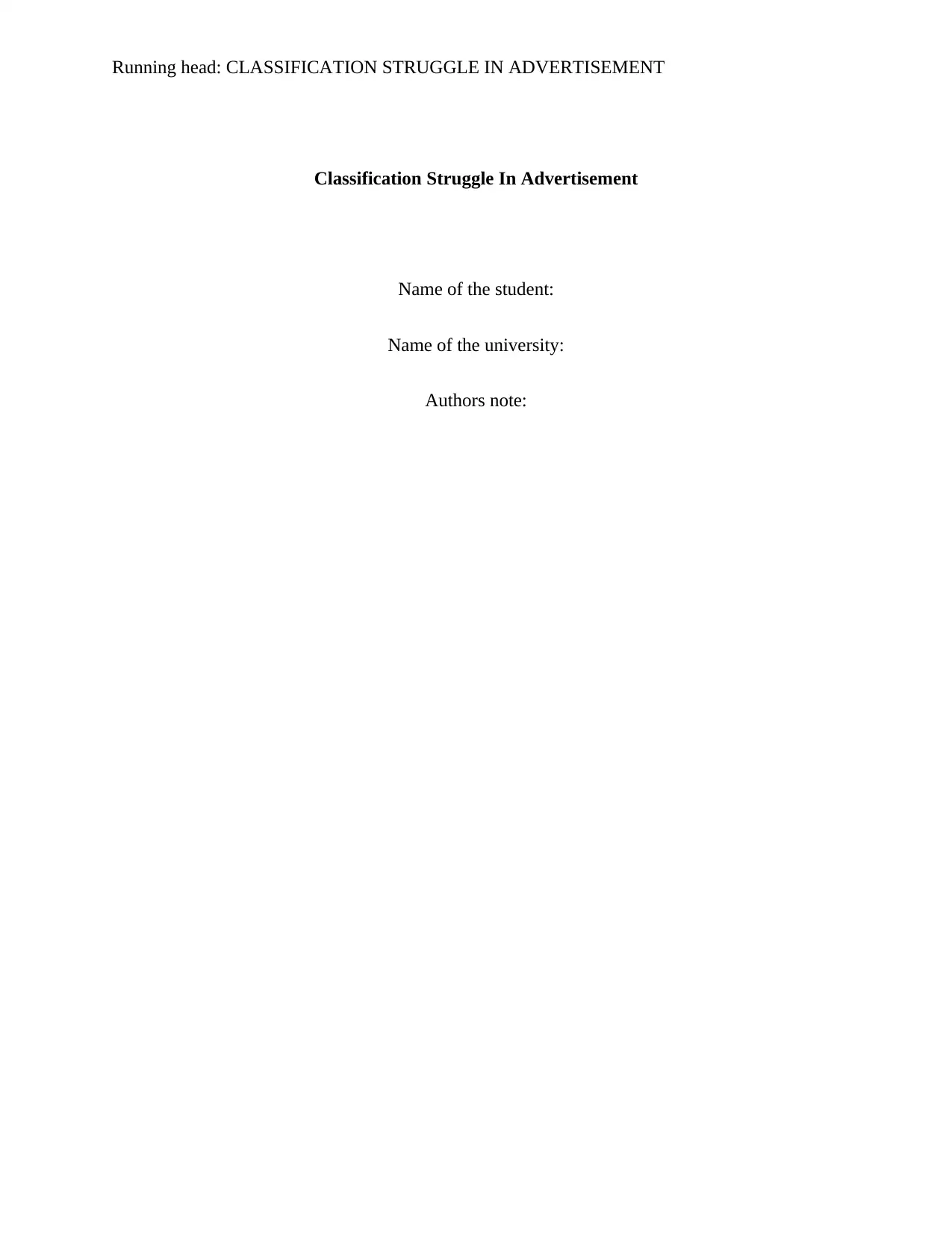
Running head: CLASSIFICATION STRUGGLE IN ADVERTISEMENT
Classification Struggle In Advertisement
Name of the student:
Name of the university:
Authors note:
Classification Struggle In Advertisement
Name of the student:
Name of the university:
Authors note:
Paraphrase This Document
Need a fresh take? Get an instant paraphrase of this document with our AI Paraphraser
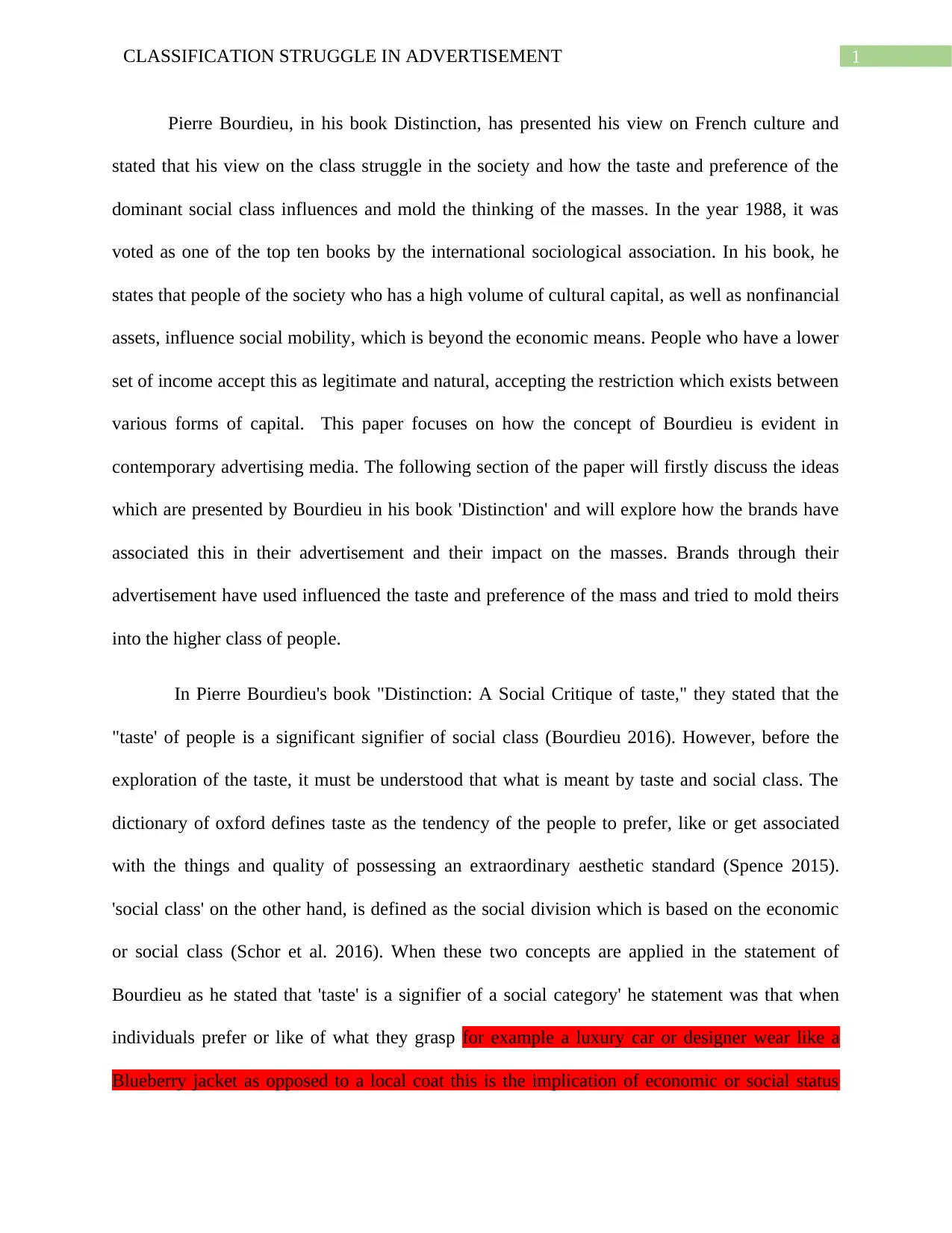
1CLASSIFICATION STRUGGLE IN ADVERTISEMENT
Pierre Bourdieu, in his book Distinction, has presented his view on French culture and
stated that his view on the class struggle in the society and how the taste and preference of the
dominant social class influences and mold the thinking of the masses. In the year 1988, it was
voted as one of the top ten books by the international sociological association. In his book, he
states that people of the society who has a high volume of cultural capital, as well as nonfinancial
assets, influence social mobility, which is beyond the economic means. People who have a lower
set of income accept this as legitimate and natural, accepting the restriction which exists between
various forms of capital. This paper focuses on how the concept of Bourdieu is evident in
contemporary advertising media. The following section of the paper will firstly discuss the ideas
which are presented by Bourdieu in his book 'Distinction' and will explore how the brands have
associated this in their advertisement and their impact on the masses. Brands through their
advertisement have used influenced the taste and preference of the mass and tried to mold theirs
into the higher class of people.
In Pierre Bourdieu's book "Distinction: A Social Critique of taste," they stated that the
"taste' of people is a significant signifier of social class (Bourdieu 2016). However, before the
exploration of the taste, it must be understood that what is meant by taste and social class. The
dictionary of oxford defines taste as the tendency of the people to prefer, like or get associated
with the things and quality of possessing an extraordinary aesthetic standard (Spence 2015).
'social class' on the other hand, is defined as the social division which is based on the economic
or social class (Schor et al. 2016). When these two concepts are applied in the statement of
Bourdieu as he stated that 'taste' is a signifier of a social category' he statement was that when
individuals prefer or like of what they grasp for example a luxury car or designer wear like a
Blueberry jacket as opposed to a local coat this is the implication of economic or social status
Pierre Bourdieu, in his book Distinction, has presented his view on French culture and
stated that his view on the class struggle in the society and how the taste and preference of the
dominant social class influences and mold the thinking of the masses. In the year 1988, it was
voted as one of the top ten books by the international sociological association. In his book, he
states that people of the society who has a high volume of cultural capital, as well as nonfinancial
assets, influence social mobility, which is beyond the economic means. People who have a lower
set of income accept this as legitimate and natural, accepting the restriction which exists between
various forms of capital. This paper focuses on how the concept of Bourdieu is evident in
contemporary advertising media. The following section of the paper will firstly discuss the ideas
which are presented by Bourdieu in his book 'Distinction' and will explore how the brands have
associated this in their advertisement and their impact on the masses. Brands through their
advertisement have used influenced the taste and preference of the mass and tried to mold theirs
into the higher class of people.
In Pierre Bourdieu's book "Distinction: A Social Critique of taste," they stated that the
"taste' of people is a significant signifier of social class (Bourdieu 2016). However, before the
exploration of the taste, it must be understood that what is meant by taste and social class. The
dictionary of oxford defines taste as the tendency of the people to prefer, like or get associated
with the things and quality of possessing an extraordinary aesthetic standard (Spence 2015).
'social class' on the other hand, is defined as the social division which is based on the economic
or social class (Schor et al. 2016). When these two concepts are applied in the statement of
Bourdieu as he stated that 'taste' is a signifier of a social category' he statement was that when
individuals prefer or like of what they grasp for example a luxury car or designer wear like a
Blueberry jacket as opposed to a local coat this is the implication of economic or social status
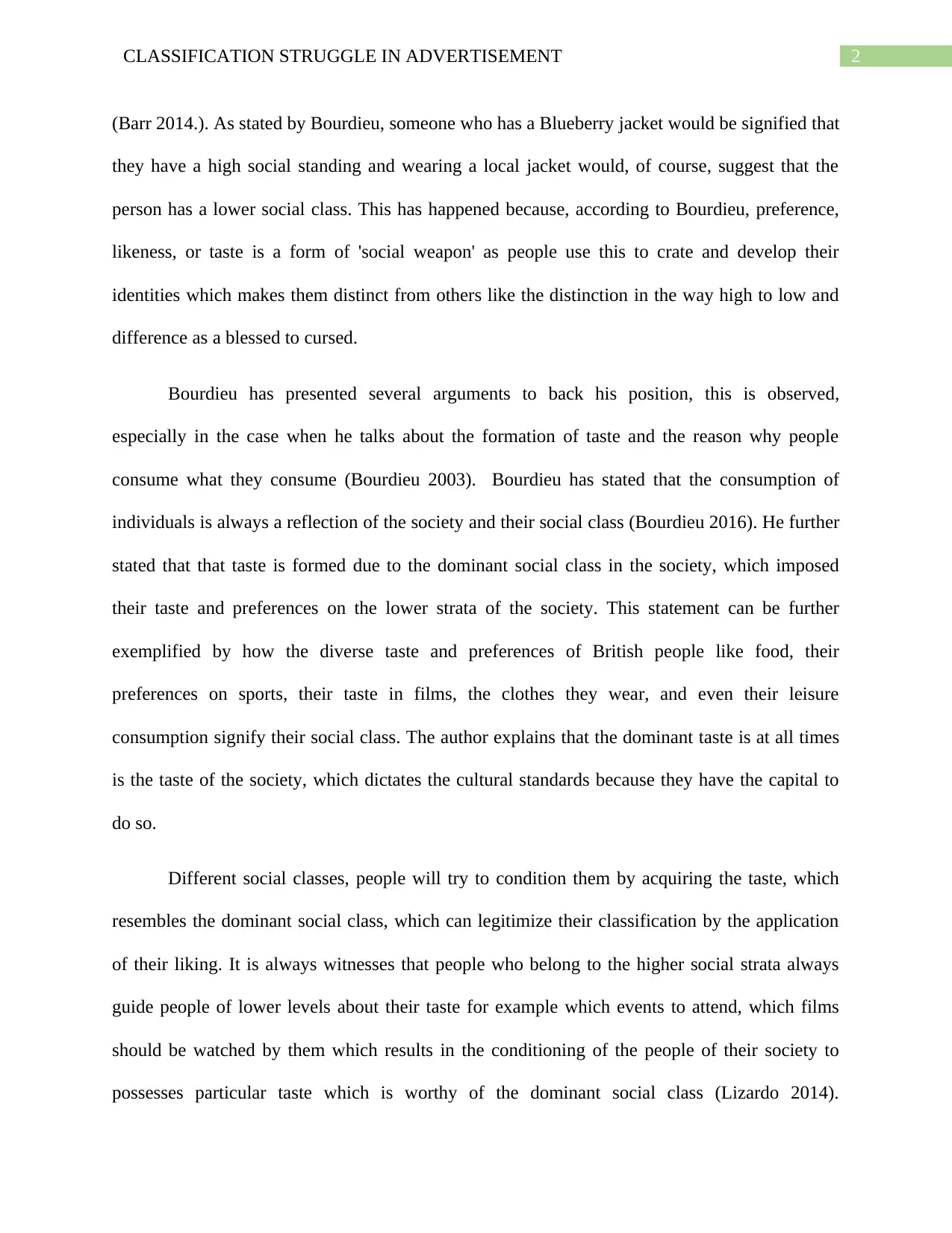
2CLASSIFICATION STRUGGLE IN ADVERTISEMENT
(Barr 2014.). As stated by Bourdieu, someone who has a Blueberry jacket would be signified that
they have a high social standing and wearing a local jacket would, of course, suggest that the
person has a lower social class. This has happened because, according to Bourdieu, preference,
likeness, or taste is a form of 'social weapon' as people use this to crate and develop their
identities which makes them distinct from others like the distinction in the way high to low and
difference as a blessed to cursed.
Bourdieu has presented several arguments to back his position, this is observed,
especially in the case when he talks about the formation of taste and the reason why people
consume what they consume (Bourdieu 2003). Bourdieu has stated that the consumption of
individuals is always a reflection of the society and their social class (Bourdieu 2016). He further
stated that that taste is formed due to the dominant social class in the society, which imposed
their taste and preferences on the lower strata of the society. This statement can be further
exemplified by how the diverse taste and preferences of British people like food, their
preferences on sports, their taste in films, the clothes they wear, and even their leisure
consumption signify their social class. The author explains that the dominant taste is at all times
is the taste of the society, which dictates the cultural standards because they have the capital to
do so.
Different social classes, people will try to condition them by acquiring the taste, which
resembles the dominant social class, which can legitimize their classification by the application
of their liking. It is always witnesses that people who belong to the higher social strata always
guide people of lower levels about their taste for example which events to attend, which films
should be watched by them which results in the conditioning of the people of their society to
possesses particular taste which is worthy of the dominant social class (Lizardo 2014).
(Barr 2014.). As stated by Bourdieu, someone who has a Blueberry jacket would be signified that
they have a high social standing and wearing a local jacket would, of course, suggest that the
person has a lower social class. This has happened because, according to Bourdieu, preference,
likeness, or taste is a form of 'social weapon' as people use this to crate and develop their
identities which makes them distinct from others like the distinction in the way high to low and
difference as a blessed to cursed.
Bourdieu has presented several arguments to back his position, this is observed,
especially in the case when he talks about the formation of taste and the reason why people
consume what they consume (Bourdieu 2003). Bourdieu has stated that the consumption of
individuals is always a reflection of the society and their social class (Bourdieu 2016). He further
stated that that taste is formed due to the dominant social class in the society, which imposed
their taste and preferences on the lower strata of the society. This statement can be further
exemplified by how the diverse taste and preferences of British people like food, their
preferences on sports, their taste in films, the clothes they wear, and even their leisure
consumption signify their social class. The author explains that the dominant taste is at all times
is the taste of the society, which dictates the cultural standards because they have the capital to
do so.
Different social classes, people will try to condition them by acquiring the taste, which
resembles the dominant social class, which can legitimize their classification by the application
of their liking. It is always witnesses that people who belong to the higher social strata always
guide people of lower levels about their taste for example which events to attend, which films
should be watched by them which results in the conditioning of the people of their society to
possesses particular taste which is worthy of the dominant social class (Lizardo 2014).
⊘ This is a preview!⊘
Do you want full access?
Subscribe today to unlock all pages.

Trusted by 1+ million students worldwide
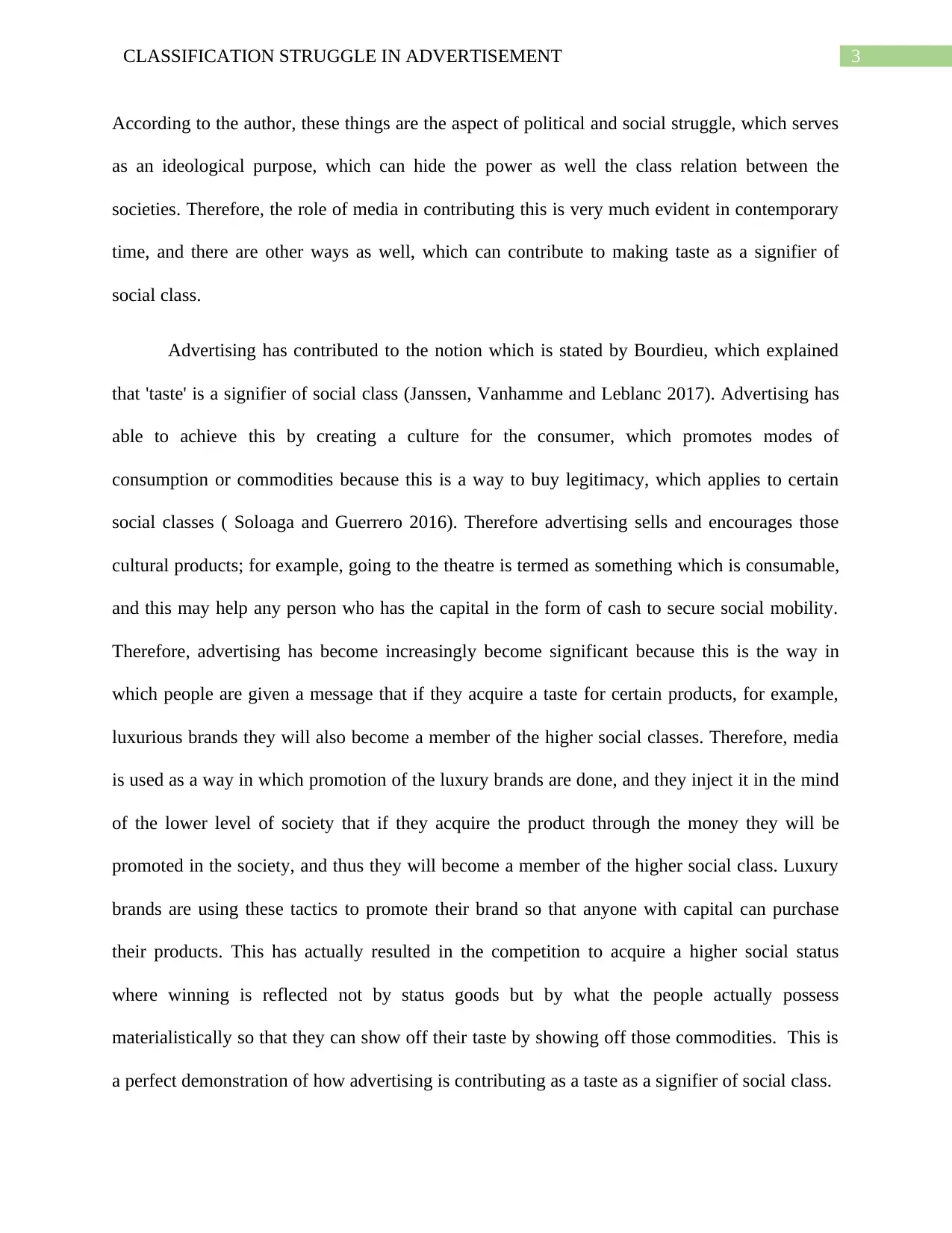
3CLASSIFICATION STRUGGLE IN ADVERTISEMENT
According to the author, these things are the aspect of political and social struggle, which serves
as an ideological purpose, which can hide the power as well the class relation between the
societies. Therefore, the role of media in contributing this is very much evident in contemporary
time, and there are other ways as well, which can contribute to making taste as a signifier of
social class.
Advertising has contributed to the notion which is stated by Bourdieu, which explained
that 'taste' is a signifier of social class (Janssen, Vanhamme and Leblanc 2017). Advertising has
able to achieve this by creating a culture for the consumer, which promotes modes of
consumption or commodities because this is a way to buy legitimacy, which applies to certain
social classes ( Soloaga and Guerrero 2016). Therefore advertising sells and encourages those
cultural products; for example, going to the theatre is termed as something which is consumable,
and this may help any person who has the capital in the form of cash to secure social mobility.
Therefore, advertising has become increasingly become significant because this is the way in
which people are given a message that if they acquire a taste for certain products, for example,
luxurious brands they will also become a member of the higher social classes. Therefore, media
is used as a way in which promotion of the luxury brands are done, and they inject it in the mind
of the lower level of society that if they acquire the product through the money they will be
promoted in the society, and thus they will become a member of the higher social class. Luxury
brands are using these tactics to promote their brand so that anyone with capital can purchase
their products. This has actually resulted in the competition to acquire a higher social status
where winning is reflected not by status goods but by what the people actually possess
materialistically so that they can show off their taste by showing off those commodities. This is
a perfect demonstration of how advertising is contributing as a taste as a signifier of social class.
According to the author, these things are the aspect of political and social struggle, which serves
as an ideological purpose, which can hide the power as well the class relation between the
societies. Therefore, the role of media in contributing this is very much evident in contemporary
time, and there are other ways as well, which can contribute to making taste as a signifier of
social class.
Advertising has contributed to the notion which is stated by Bourdieu, which explained
that 'taste' is a signifier of social class (Janssen, Vanhamme and Leblanc 2017). Advertising has
able to achieve this by creating a culture for the consumer, which promotes modes of
consumption or commodities because this is a way to buy legitimacy, which applies to certain
social classes ( Soloaga and Guerrero 2016). Therefore advertising sells and encourages those
cultural products; for example, going to the theatre is termed as something which is consumable,
and this may help any person who has the capital in the form of cash to secure social mobility.
Therefore, advertising has become increasingly become significant because this is the way in
which people are given a message that if they acquire a taste for certain products, for example,
luxurious brands they will also become a member of the higher social classes. Therefore, media
is used as a way in which promotion of the luxury brands are done, and they inject it in the mind
of the lower level of society that if they acquire the product through the money they will be
promoted in the society, and thus they will become a member of the higher social class. Luxury
brands are using these tactics to promote their brand so that anyone with capital can purchase
their products. This has actually resulted in the competition to acquire a higher social status
where winning is reflected not by status goods but by what the people actually possess
materialistically so that they can show off their taste by showing off those commodities. This is
a perfect demonstration of how advertising is contributing as a taste as a signifier of social class.
Paraphrase This Document
Need a fresh take? Get an instant paraphrase of this document with our AI Paraphraser
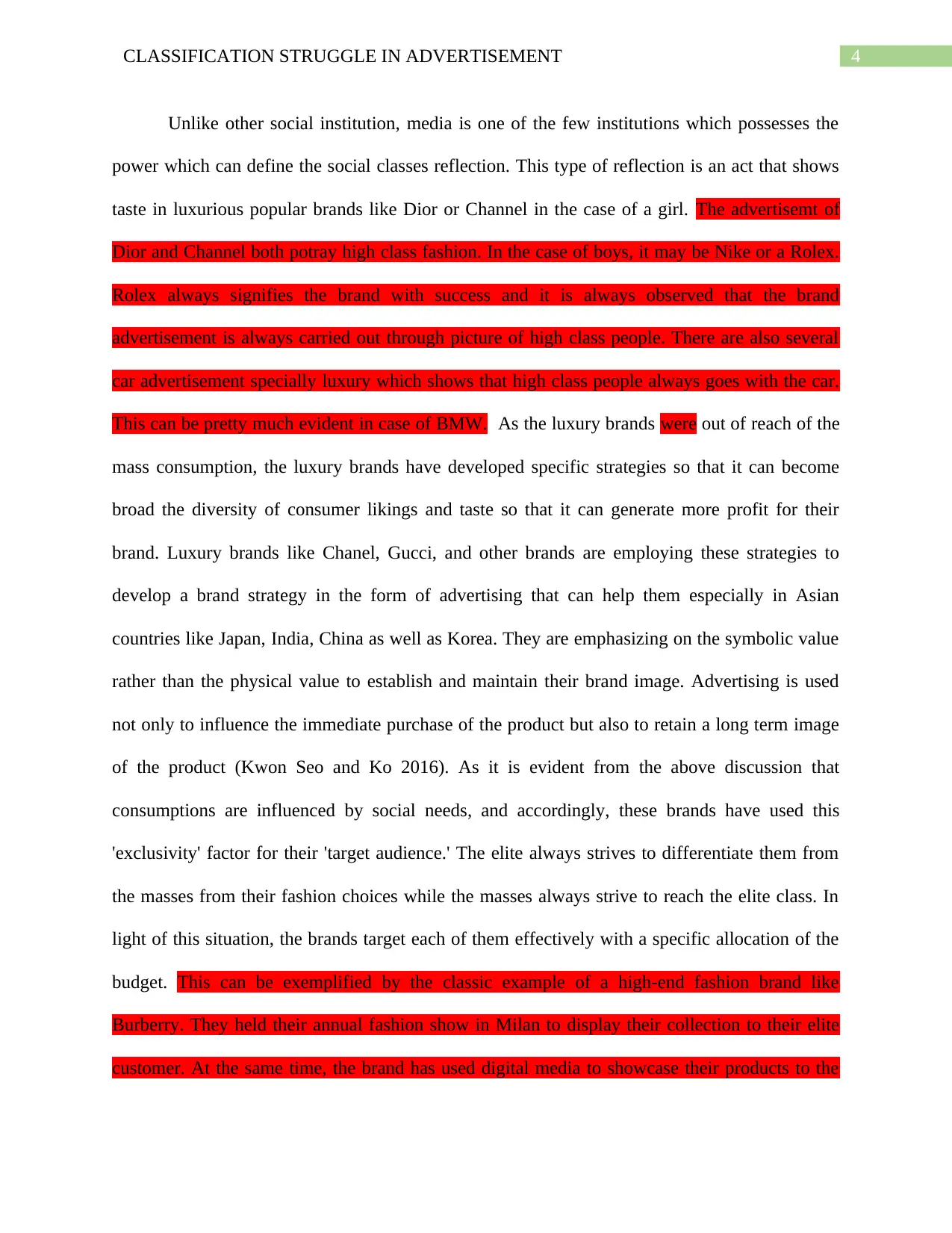
4CLASSIFICATION STRUGGLE IN ADVERTISEMENT
Unlike other social institution, media is one of the few institutions which possesses the
power which can define the social classes reflection. This type of reflection is an act that shows
taste in luxurious popular brands like Dior or Channel in the case of a girl. The advertisemt of
Dior and Channel both potray high class fashion. In the case of boys, it may be Nike or a Rolex.
Rolex always signifies the brand with success and it is always observed that the brand
advertisement is always carried out through picture of high class people. There are also several
car advertisement specially luxury which shows that high class people always goes with the car.
This can be pretty much evident in case of BMW. As the luxury brands were out of reach of the
mass consumption, the luxury brands have developed specific strategies so that it can become
broad the diversity of consumer likings and taste so that it can generate more profit for their
brand. Luxury brands like Chanel, Gucci, and other brands are employing these strategies to
develop a brand strategy in the form of advertising that can help them especially in Asian
countries like Japan, India, China as well as Korea. They are emphasizing on the symbolic value
rather than the physical value to establish and maintain their brand image. Advertising is used
not only to influence the immediate purchase of the product but also to retain a long term image
of the product (Kwon Seo and Ko 2016). As it is evident from the above discussion that
consumptions are influenced by social needs, and accordingly, these brands have used this
'exclusivity' factor for their 'target audience.' The elite always strives to differentiate them from
the masses from their fashion choices while the masses always strive to reach the elite class. In
light of this situation, the brands target each of them effectively with a specific allocation of the
budget. This can be exemplified by the classic example of a high-end fashion brand like
Burberry. They held their annual fashion show in Milan to display their collection to their elite
customer. At the same time, the brand has used digital media to showcase their products to the
Unlike other social institution, media is one of the few institutions which possesses the
power which can define the social classes reflection. This type of reflection is an act that shows
taste in luxurious popular brands like Dior or Channel in the case of a girl. The advertisemt of
Dior and Channel both potray high class fashion. In the case of boys, it may be Nike or a Rolex.
Rolex always signifies the brand with success and it is always observed that the brand
advertisement is always carried out through picture of high class people. There are also several
car advertisement specially luxury which shows that high class people always goes with the car.
This can be pretty much evident in case of BMW. As the luxury brands were out of reach of the
mass consumption, the luxury brands have developed specific strategies so that it can become
broad the diversity of consumer likings and taste so that it can generate more profit for their
brand. Luxury brands like Chanel, Gucci, and other brands are employing these strategies to
develop a brand strategy in the form of advertising that can help them especially in Asian
countries like Japan, India, China as well as Korea. They are emphasizing on the symbolic value
rather than the physical value to establish and maintain their brand image. Advertising is used
not only to influence the immediate purchase of the product but also to retain a long term image
of the product (Kwon Seo and Ko 2016). As it is evident from the above discussion that
consumptions are influenced by social needs, and accordingly, these brands have used this
'exclusivity' factor for their 'target audience.' The elite always strives to differentiate them from
the masses from their fashion choices while the masses always strive to reach the elite class. In
light of this situation, the brands target each of them effectively with a specific allocation of the
budget. This can be exemplified by the classic example of a high-end fashion brand like
Burberry. They held their annual fashion show in Milan to display their collection to their elite
customer. At the same time, the brand has used digital media to showcase their products to the
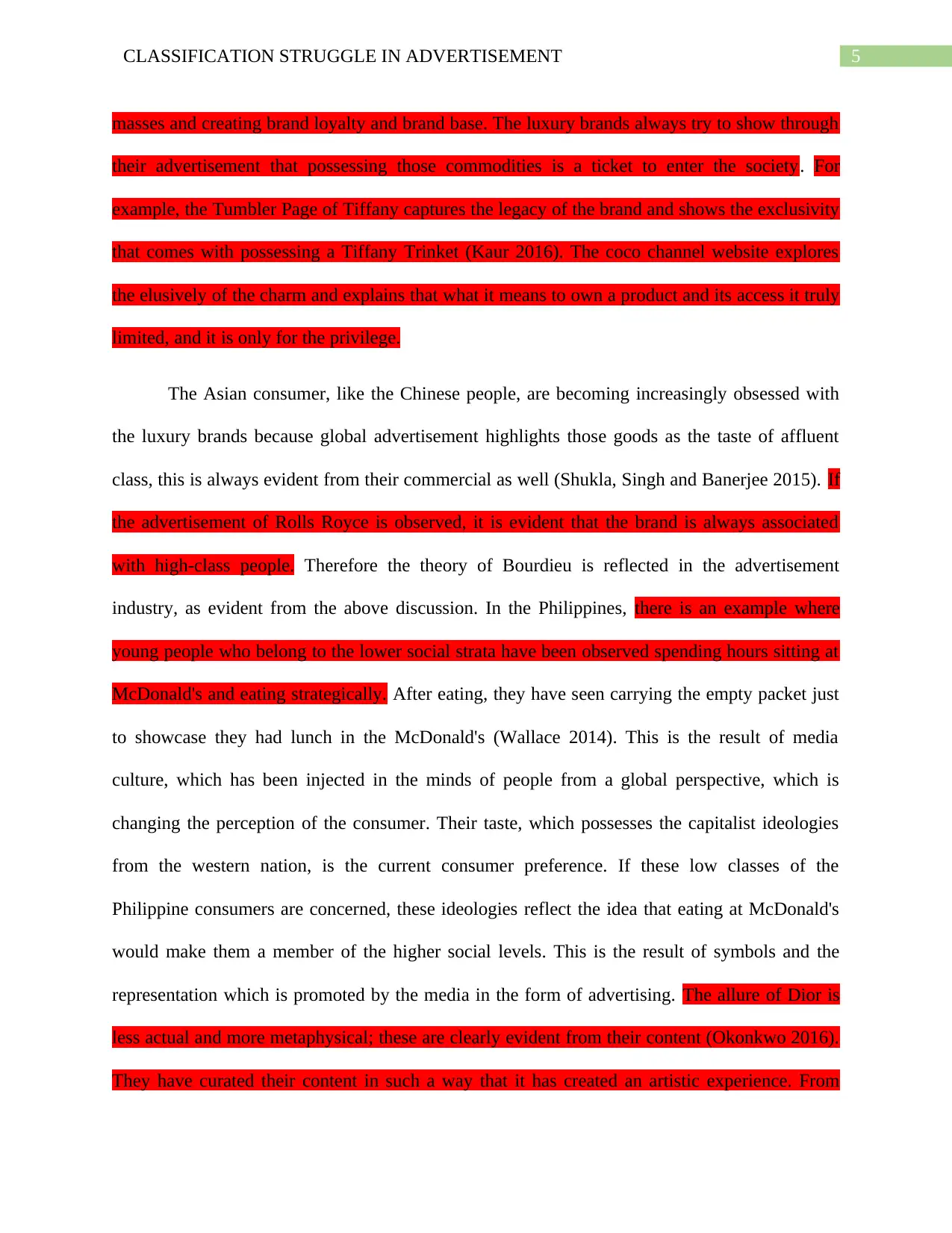
5CLASSIFICATION STRUGGLE IN ADVERTISEMENT
masses and creating brand loyalty and brand base. The luxury brands always try to show through
their advertisement that possessing those commodities is a ticket to enter the society. For
example, the Tumbler Page of Tiffany captures the legacy of the brand and shows the exclusivity
that comes with possessing a Tiffany Trinket (Kaur 2016). The coco channel website explores
the elusively of the charm and explains that what it means to own a product and its access it truly
limited, and it is only for the privilege.
The Asian consumer, like the Chinese people, are becoming increasingly obsessed with
the luxury brands because global advertisement highlights those goods as the taste of affluent
class, this is always evident from their commercial as well (Shukla, Singh and Banerjee 2015). If
the advertisement of Rolls Royce is observed, it is evident that the brand is always associated
with high-class people. Therefore the theory of Bourdieu is reflected in the advertisement
industry, as evident from the above discussion. In the Philippines, there is an example where
young people who belong to the lower social strata have been observed spending hours sitting at
McDonald's and eating strategically. After eating, they have seen carrying the empty packet just
to showcase they had lunch in the McDonald's (Wallace 2014). This is the result of media
culture, which has been injected in the minds of people from a global perspective, which is
changing the perception of the consumer. Their taste, which possesses the capitalist ideologies
from the western nation, is the current consumer preference. If these low classes of the
Philippine consumers are concerned, these ideologies reflect the idea that eating at McDonald's
would make them a member of the higher social levels. This is the result of symbols and the
representation which is promoted by the media in the form of advertising. The allure of Dior is
less actual and more metaphysical; these are clearly evident from their content (Okonkwo 2016).
They have curated their content in such a way that it has created an artistic experience. From
masses and creating brand loyalty and brand base. The luxury brands always try to show through
their advertisement that possessing those commodities is a ticket to enter the society. For
example, the Tumbler Page of Tiffany captures the legacy of the brand and shows the exclusivity
that comes with possessing a Tiffany Trinket (Kaur 2016). The coco channel website explores
the elusively of the charm and explains that what it means to own a product and its access it truly
limited, and it is only for the privilege.
The Asian consumer, like the Chinese people, are becoming increasingly obsessed with
the luxury brands because global advertisement highlights those goods as the taste of affluent
class, this is always evident from their commercial as well (Shukla, Singh and Banerjee 2015). If
the advertisement of Rolls Royce is observed, it is evident that the brand is always associated
with high-class people. Therefore the theory of Bourdieu is reflected in the advertisement
industry, as evident from the above discussion. In the Philippines, there is an example where
young people who belong to the lower social strata have been observed spending hours sitting at
McDonald's and eating strategically. After eating, they have seen carrying the empty packet just
to showcase they had lunch in the McDonald's (Wallace 2014). This is the result of media
culture, which has been injected in the minds of people from a global perspective, which is
changing the perception of the consumer. Their taste, which possesses the capitalist ideologies
from the western nation, is the current consumer preference. If these low classes of the
Philippine consumers are concerned, these ideologies reflect the idea that eating at McDonald's
would make them a member of the higher social levels. This is the result of symbols and the
representation which is promoted by the media in the form of advertising. The allure of Dior is
less actual and more metaphysical; these are clearly evident from their content (Okonkwo 2016).
They have curated their content in such a way that it has created an artistic experience. From
⊘ This is a preview!⊘
Do you want full access?
Subscribe today to unlock all pages.

Trusted by 1+ million students worldwide
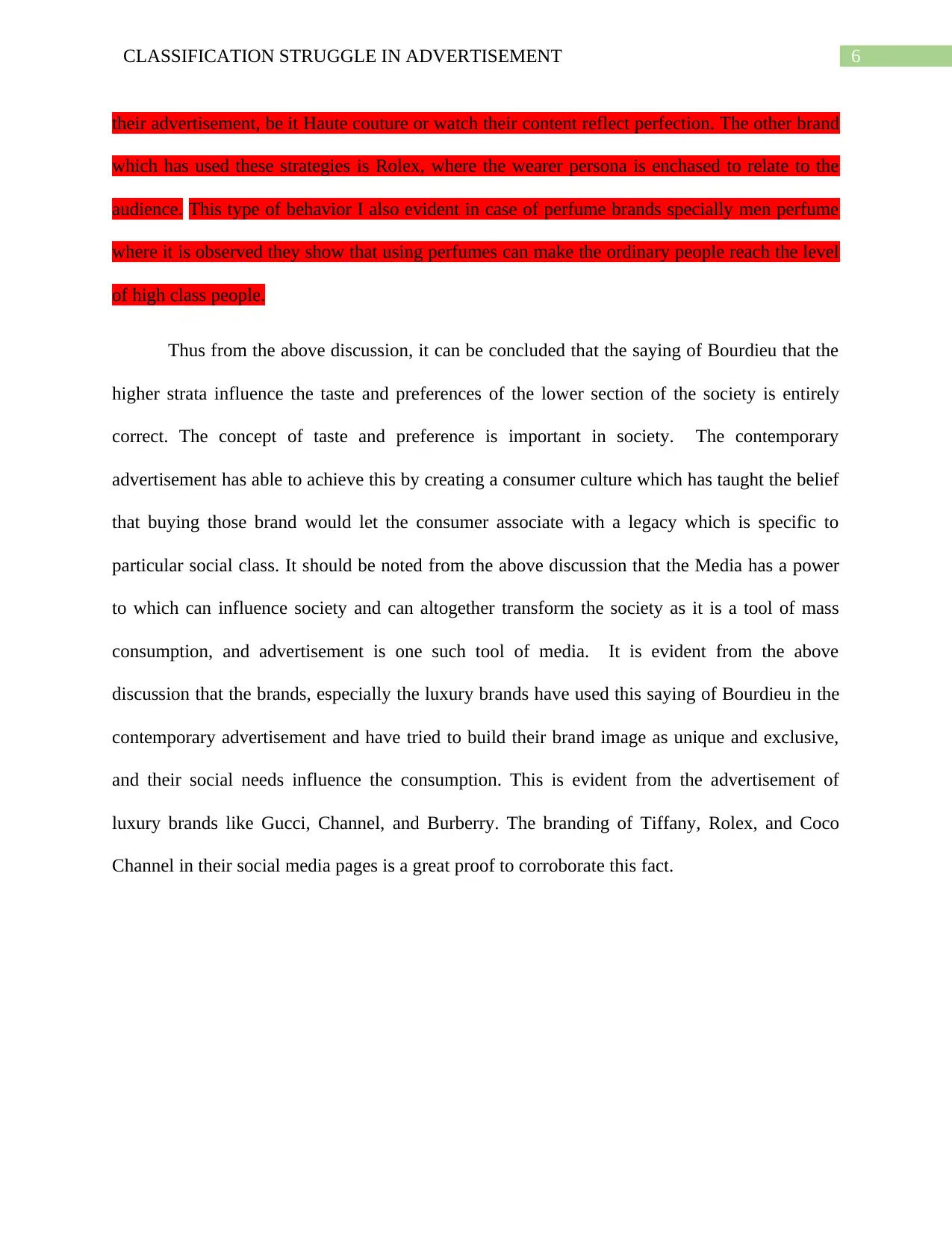
6CLASSIFICATION STRUGGLE IN ADVERTISEMENT
their advertisement, be it Haute couture or watch their content reflect perfection. The other brand
which has used these strategies is Rolex, where the wearer persona is enchased to relate to the
audience. This type of behavior I also evident in case of perfume brands specially men perfume
where it is observed they show that using perfumes can make the ordinary people reach the level
of high class people.
Thus from the above discussion, it can be concluded that the saying of Bourdieu that the
higher strata influence the taste and preferences of the lower section of the society is entirely
correct. The concept of taste and preference is important in society. The contemporary
advertisement has able to achieve this by creating a consumer culture which has taught the belief
that buying those brand would let the consumer associate with a legacy which is specific to
particular social class. It should be noted from the above discussion that the Media has a power
to which can influence society and can altogether transform the society as it is a tool of mass
consumption, and advertisement is one such tool of media. It is evident from the above
discussion that the brands, especially the luxury brands have used this saying of Bourdieu in the
contemporary advertisement and have tried to build their brand image as unique and exclusive,
and their social needs influence the consumption. This is evident from the advertisement of
luxury brands like Gucci, Channel, and Burberry. The branding of Tiffany, Rolex, and Coco
Channel in their social media pages is a great proof to corroborate this fact.
their advertisement, be it Haute couture or watch their content reflect perfection. The other brand
which has used these strategies is Rolex, where the wearer persona is enchased to relate to the
audience. This type of behavior I also evident in case of perfume brands specially men perfume
where it is observed they show that using perfumes can make the ordinary people reach the level
of high class people.
Thus from the above discussion, it can be concluded that the saying of Bourdieu that the
higher strata influence the taste and preferences of the lower section of the society is entirely
correct. The concept of taste and preference is important in society. The contemporary
advertisement has able to achieve this by creating a consumer culture which has taught the belief
that buying those brand would let the consumer associate with a legacy which is specific to
particular social class. It should be noted from the above discussion that the Media has a power
to which can influence society and can altogether transform the society as it is a tool of mass
consumption, and advertisement is one such tool of media. It is evident from the above
discussion that the brands, especially the luxury brands have used this saying of Bourdieu in the
contemporary advertisement and have tried to build their brand image as unique and exclusive,
and their social needs influence the consumption. This is evident from the advertisement of
luxury brands like Gucci, Channel, and Burberry. The branding of Tiffany, Rolex, and Coco
Channel in their social media pages is a great proof to corroborate this fact.
Paraphrase This Document
Need a fresh take? Get an instant paraphrase of this document with our AI Paraphraser
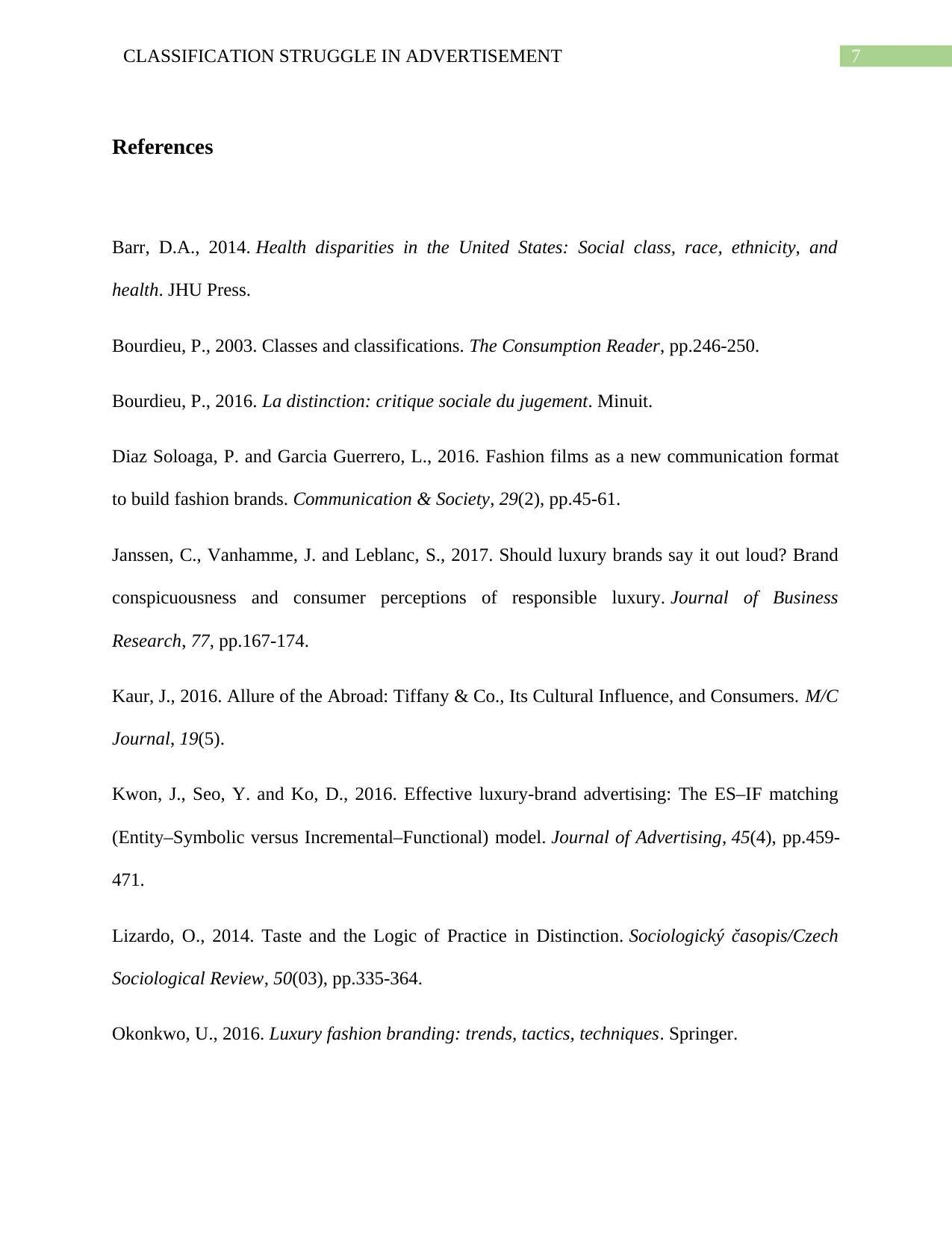
7CLASSIFICATION STRUGGLE IN ADVERTISEMENT
References
Barr, D.A., 2014. Health disparities in the United States: Social class, race, ethnicity, and
health. JHU Press.
Bourdieu, P., 2003. Classes and classifications. The Consumption Reader, pp.246-250.
Bourdieu, P., 2016. La distinction: critique sociale du jugement. Minuit.
Diaz Soloaga, P. and Garcia Guerrero, L., 2016. Fashion films as a new communication format
to build fashion brands. Communication & Society, 29(2), pp.45-61.
Janssen, C., Vanhamme, J. and Leblanc, S., 2017. Should luxury brands say it out loud? Brand
conspicuousness and consumer perceptions of responsible luxury. Journal of Business
Research, 77, pp.167-174.
Kaur, J., 2016. Allure of the Abroad: Tiffany & Co., Its Cultural Influence, and Consumers. M/C
Journal, 19(5).
Kwon, J., Seo, Y. and Ko, D., 2016. Effective luxury-brand advertising: The ES–IF matching
(Entity–Symbolic versus Incremental–Functional) model. Journal of Advertising, 45(4), pp.459-
471.
Lizardo, O., 2014. Taste and the Logic of Practice in Distinction. Sociologický časopis/Czech
Sociological Review, 50(03), pp.335-364.
Okonkwo, U., 2016. Luxury fashion branding: trends, tactics, techniques. Springer.
References
Barr, D.A., 2014. Health disparities in the United States: Social class, race, ethnicity, and
health. JHU Press.
Bourdieu, P., 2003. Classes and classifications. The Consumption Reader, pp.246-250.
Bourdieu, P., 2016. La distinction: critique sociale du jugement. Minuit.
Diaz Soloaga, P. and Garcia Guerrero, L., 2016. Fashion films as a new communication format
to build fashion brands. Communication & Society, 29(2), pp.45-61.
Janssen, C., Vanhamme, J. and Leblanc, S., 2017. Should luxury brands say it out loud? Brand
conspicuousness and consumer perceptions of responsible luxury. Journal of Business
Research, 77, pp.167-174.
Kaur, J., 2016. Allure of the Abroad: Tiffany & Co., Its Cultural Influence, and Consumers. M/C
Journal, 19(5).
Kwon, J., Seo, Y. and Ko, D., 2016. Effective luxury-brand advertising: The ES–IF matching
(Entity–Symbolic versus Incremental–Functional) model. Journal of Advertising, 45(4), pp.459-
471.
Lizardo, O., 2014. Taste and the Logic of Practice in Distinction. Sociologický časopis/Czech
Sociological Review, 50(03), pp.335-364.
Okonkwo, U., 2016. Luxury fashion branding: trends, tactics, techniques. Springer.
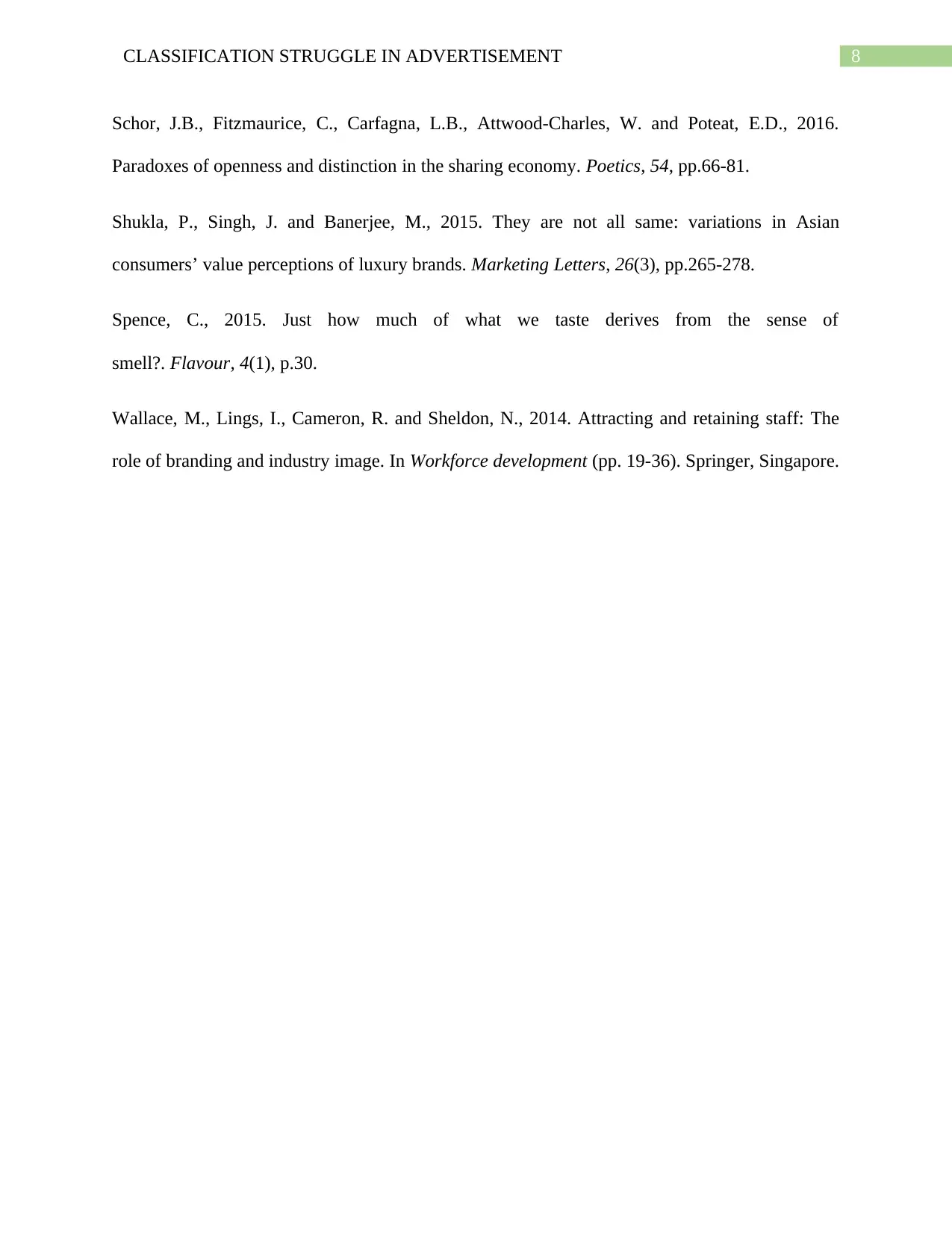
8CLASSIFICATION STRUGGLE IN ADVERTISEMENT
Schor, J.B., Fitzmaurice, C., Carfagna, L.B., Attwood-Charles, W. and Poteat, E.D., 2016.
Paradoxes of openness and distinction in the sharing economy. Poetics, 54, pp.66-81.
Shukla, P., Singh, J. and Banerjee, M., 2015. They are not all same: variations in Asian
consumers’ value perceptions of luxury brands. Marketing Letters, 26(3), pp.265-278.
Spence, C., 2015. Just how much of what we taste derives from the sense of
smell?. Flavour, 4(1), p.30.
Wallace, M., Lings, I., Cameron, R. and Sheldon, N., 2014. Attracting and retaining staff: The
role of branding and industry image. In Workforce development (pp. 19-36). Springer, Singapore.
Schor, J.B., Fitzmaurice, C., Carfagna, L.B., Attwood-Charles, W. and Poteat, E.D., 2016.
Paradoxes of openness and distinction in the sharing economy. Poetics, 54, pp.66-81.
Shukla, P., Singh, J. and Banerjee, M., 2015. They are not all same: variations in Asian
consumers’ value perceptions of luxury brands. Marketing Letters, 26(3), pp.265-278.
Spence, C., 2015. Just how much of what we taste derives from the sense of
smell?. Flavour, 4(1), p.30.
Wallace, M., Lings, I., Cameron, R. and Sheldon, N., 2014. Attracting and retaining staff: The
role of branding and industry image. In Workforce development (pp. 19-36). Springer, Singapore.
⊘ This is a preview!⊘
Do you want full access?
Subscribe today to unlock all pages.

Trusted by 1+ million students worldwide
1 out of 9
Related Documents
Your All-in-One AI-Powered Toolkit for Academic Success.
+13062052269
info@desklib.com
Available 24*7 on WhatsApp / Email
![[object Object]](/_next/static/media/star-bottom.7253800d.svg)
Unlock your academic potential
Copyright © 2020–2025 A2Z Services. All Rights Reserved. Developed and managed by ZUCOL.




